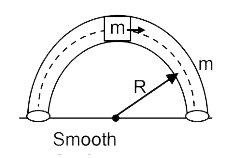Eustachian tube
connects buccal cavity with middle ear
causes vibration in perilymph surrounding the ear ossicles
induces vibrations in tympanum
conducts sound wave from the auditory meatus to internal ear
The correct Answer is:A
Step-by-Step Solution:
1. Understanding the Eustachian Tube: The Eustachian tube is a narrow passage that connects the middle ear to the nasopharynx (the upper part of the throat behind the nose). Its primary function is to equalize air pressure on both sides of the eardrum and to drain any fluid from the middle ear.
2. Analyzing the Options:
- Option 1: "Connects buccal cavity with middle ear."
- This statement is incorrect. The Eustachian tube connects the middle ear to the nasopharynx, not the buccal cavity.
- Option 2: "Causes vibration in Paralymph surrounding the Ear Ossicles."
- This statement is incorrect. The vibration in the perilymph is caused by the tympanic membrane, not the Eustachian tube.
- Option 3: "Induces vibration in tympanum."
- This statement is incorrect. The outer ear (pinna) induces vibration in the tympanic membrane (tympanum), not the Eustachian tube.
- Option 4: "Conduct sound waves from the auditory malleus to internal ear."
- This statement is incorrect. The Eustachian tube does not conduct sound waves; it primarily functions to equalize pressure.
3. Conclusion: After analyzing all the options, it is clear that the first option is the only one that is correct. However, it is important to note that the Eustachian tube does not connect the buccal cavity to the middle ear; it connects the middle ear to the nasopharynx.
Final Answer:
The correct statement regarding the Eustachian tube is that it connects the middle ear to the nasopharynx, not the buccal cavity.
- Option 1: "Connects buccal cavity with middle ear."
- This statement is incorrect. The Eustachian tube connects the middle ear to the nasopharynx, not the buccal cavity.
- Option 2: "Causes vibration in Paralymph surrounding the Ear Ossicles."
- This statement is incorrect. The vibration in the perilymph is caused by the tympanic membrane, not the Eustachian tube.
- Option 3: "Induces vibration in tympanum."
- This statement is incorrect. The outer ear (pinna) induces vibration in the tympanic membrane (tympanum), not the Eustachian tube.
- Option 4: "Conduct sound waves from the auditory malleus to internal ear."
- This statement is incorrect. The Eustachian tube does not conduct sound waves; it primarily functions to equalize pressure.
The correct statement regarding the Eustachian tube is that it connects the middle ear to the nasopharynx, not the buccal cavity.
Similar Questions
Knowledge Check
Which of the following are correct for pharynx?
I. It is a junction of buccal cavity, nasal chamber, Eustachian tube and trachea.
II. It is the aprerture, which leads into the oesophaus.
III. It is the structure, which allows air to enter into trachea.AI and IIBOnly IICAll of the aboveDNone of the aboveRead the following statements
STATEMENT A: Middle ear, which is filled with endolymph contains three ossicles which increases the amplitude of sound.
Statement B :Eustachian tube helps in equalising the pressure on either side of ear drumABoth statements are correctBonly statement A is correctConly statement B is correctDboth statements are correctSelect the correct statement ?
i. The ears perform two sensory functions, hearing and maintenance of body balance
ii. The ear ossicles increases the efficiency of transmissions of sound waves to the inner ear
iii. The Eustachian tube helps in equalising the pressure on either sides of the ear drum
iv. The fluid-filled inner ear called labyrinth
v. The membranous labyrinth is filled with a fluid called perilymph
vi. The coiled portion of the labyrinth is called cochleaAi, ii, vand viiBi, ii, iii, iv and viCi. ii, iii and viDAll of these
Eustachian valve is associated with
View SolutionWhich of the following vertebrates show the formation of middle ear (Eustachian recess) for the first time?
View Solution"Tube within a tube' type of body plan is found in
View SolutionIn a vertical smooth hollow thin tube, a block of same mass as that of tube is released as shown. When it is slightly disturbed it moves towards right. By the time the block reaches the right end of the tube, the displacement of the tube will be (where ‘R’ is the mean radius of tube, assume that the tube remains in vertical plane).

View SolutionWhich one of the following exhibits concentric 'tube within tube' plan ?
View Solution

